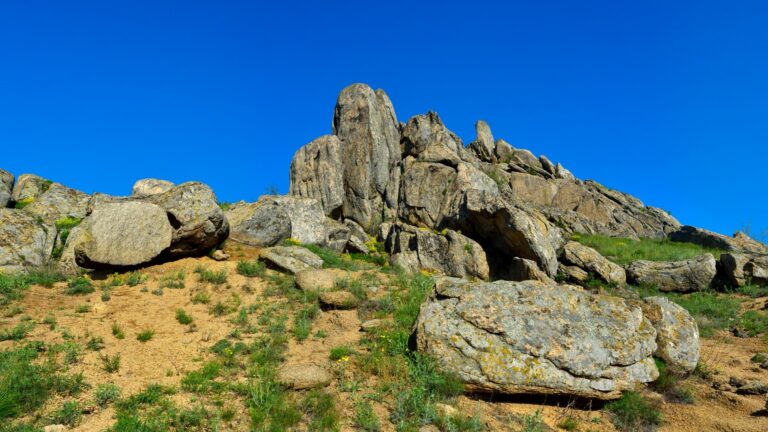Macin Mountains Flora
The great floral and vegetation wealth of the Macin Mountains is represented by over 1,770 plant species representing approximately half of the Romanian flora in only 1% of its surface. 72 species are protected as rare or endangered species, and 27 species are endemic to this region.
The importance of plant taxa in Dobrogea, in comparison with other rare plants in Romania, lies in its composition in which Black-Sea-Balkan (26.4%) and Black Sea (16.7%) species are dominant. Other species are Eurasian (12.5%), Balkan (11.1%), Mediterranean (8.3%), Black-Sea-Mediterranean (6.9%), as well as 18 (1%) Caucasian, Asian, African and cosmopolitan species.
The international importance of these rare taxa is given by the presence of the vulnerable Campanula romanica taxon a Dobrogean endemism, of 3 rare European taxa: Dianthus nardiformis (Black Sea), Centaurea tenuiflora (Black Sea, Balkan) and Centaurea gracilenta (Balkan); as well as 5 sub-endemic taxa: Corydalis solida (Balkan), Euphorbia nicaensis ssp. cadrilateri (Black Sea-Mediterranean), Moehringia grisebachii (Black Sea-Balkan), Moehringia jankae (Black Sea) and Silene cserei (Black Sea), the first four of which begin part of the European red list of vulnerable and rare taxa. Out of 72 endangered taxa, 18 are rare for Dobrogea, 5 are rare for the North of Dobrogea and one taxon – Cachrys alpina (Black Sea-Balkan) is considered extinct in the Macin Mountains.
The Macin Mountains represent the northern limit of the sub-Mediterranean area of the Balkan Peninsula and form a distinct floristic unit of the Macedo-Thracian province. The bio-geographic importance of the Macin Mountains is offered by the interference in this area of several vegetation limits of different species. Thus, this area is the southern limit of the Central-European and Caucasian species (Scutellaria orientalis, Stipa ucrainica etc.), the northern limit of Mediterranean, Balkan and Black-Sea species (Silene compacta) and the Western limit of the Eurasian Potentilla bifurca species, all of them being rare and endangered species. Also, the Macin Mountains are the only territory in the world where the endangered plant association between Gymnospermio altaicae – Celtetum glabratae, with Celtis glabrata (one of the rarest species of trees in Romania), is found and is protected.
Almost 200 years ago, Northern Dobrogea used to be covered by century-old oak forests of high productivity, whose vigorous growth only dwindled on the rocky terrain of the northern ridges and nearby the belt of the middle steppe region of Dobrogea. Dobrogea”s forests suffered major structure modifications, both before 1878 during the Ottoman dominion, when vast amounts of oak were capitalized, and after 1878 (when Dobrogea was included in Romania), when following two agrarian reforms, many forests became arable land and communal pastures, while human activity took its toll on the remaining forest areas (wood grazing, repeated application of coppice regimen with regeneration by sprouts or suckers, fires, etc.). Due to these negative factors, during 1850-1930 the forests of Dobrogea lost 63,000 hectares (approximately 40,000 in Tulcea county), reaching today only a ratio of 12% of the total territory of the county. After 1930 there is a break in the management of Dobrogea’s forests, brought by the application of coppice regimen (the regeneration of woodlands by seed), the prohibition of grazing in the woods and illegal cutting of trees, the ecological reconstruction of degraded arboretums by valuable autochthonous species, etc. As a consequence, during 1950 – 1990 ecologic reconstruction works have been performed on approximately 1,380 hectares of the Macin Mountains National Park. Works for the improvement of decayed fields have also been performed, therefore many degraded or lunar aspect fields being reduced.
Characteristic for this park is the domination of forest ecosystems, which provide for the ecological stability and optimum habitat for the special herbaceous species of this territory. The area has a rich biodiversity which is unique in the whole world, as it includes complex forest, steppe and forest-steppe ecosystems.
In the Macin Mountains one can find zones and layer of vegetation: the marginal Black Sea-Balkan steppe zone, the forest-steppe layer with sub-Mediterranean woods, the sub-Mediterranea xerothermal forests layer and the mesophilic deciduous Balkan forests layer.
On this territory 6 nationally rare woodland floristic associations have been found (it contains 4% of the forest ecosystem types in Romania, according to Donita, 1970, 1990).
In habitats with skeletal, least deep and dry soils, such as in the forest-steppe areas, there are vegetal phytocoenosis from the Nectaroscordo-Tilio tomentosae association, where oak is associated with lime, flowering ash, hornbeam (Carpinus orientalis) and ash (Fraxinus excelsior, Fraxinus coriarirefolia), etc. Shrubs are represented by European cornel, hawthorn and privet, while the herbaceous blanket is dominated by Southern species (Nectaroscerdum silicum ssp. bulgaricum, Lychnis coronaria, Arabis turrita, Lythosmermum purpureo-coeruleum, Mercurialis ovata etc.).
Near the forest-steppe, on deeper soils, the oak is replaced by gray oak, included in the Tilio tomentosae – Quercetum pedunculiflorae floristic association.
parcmacin.ro


